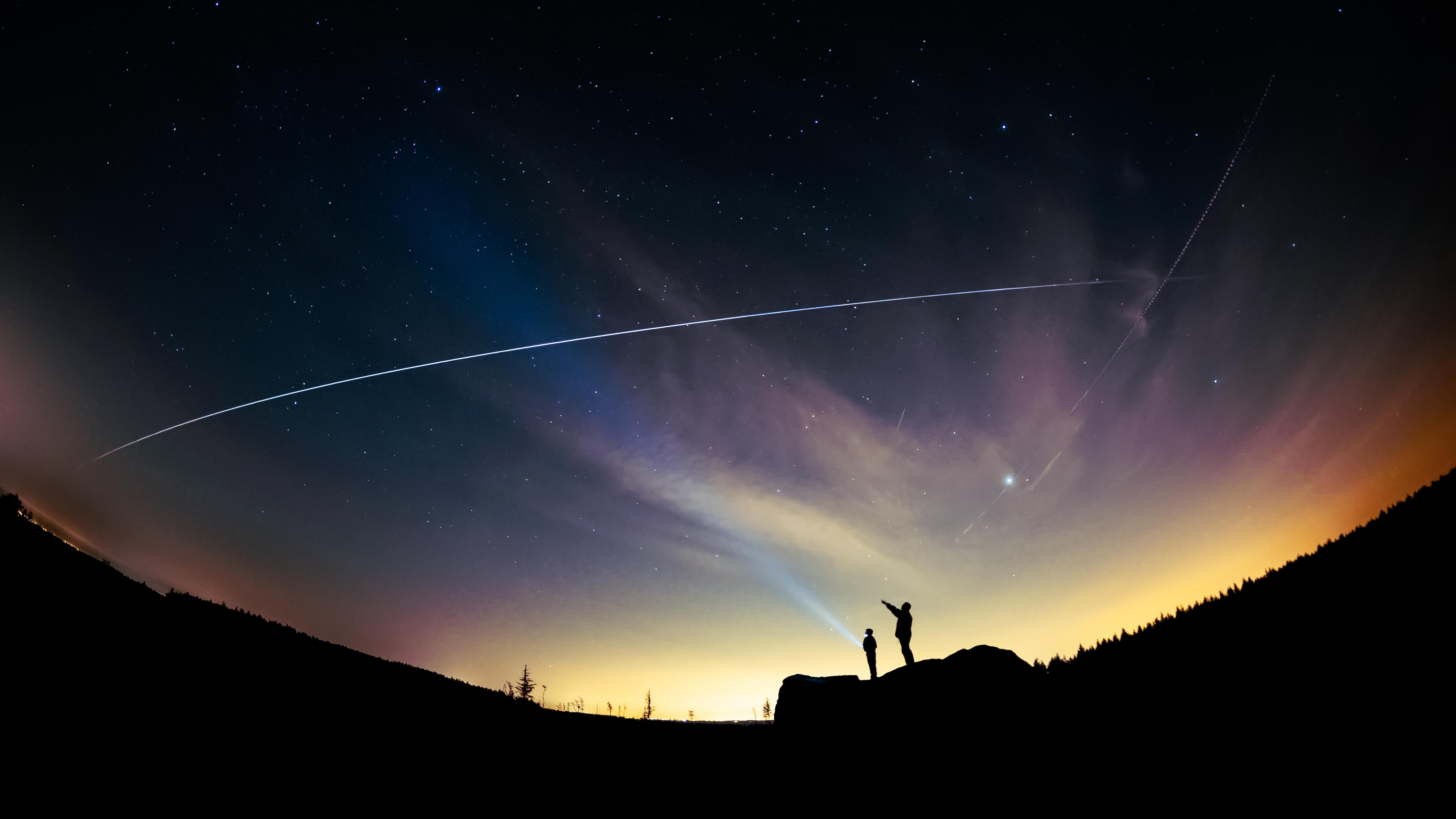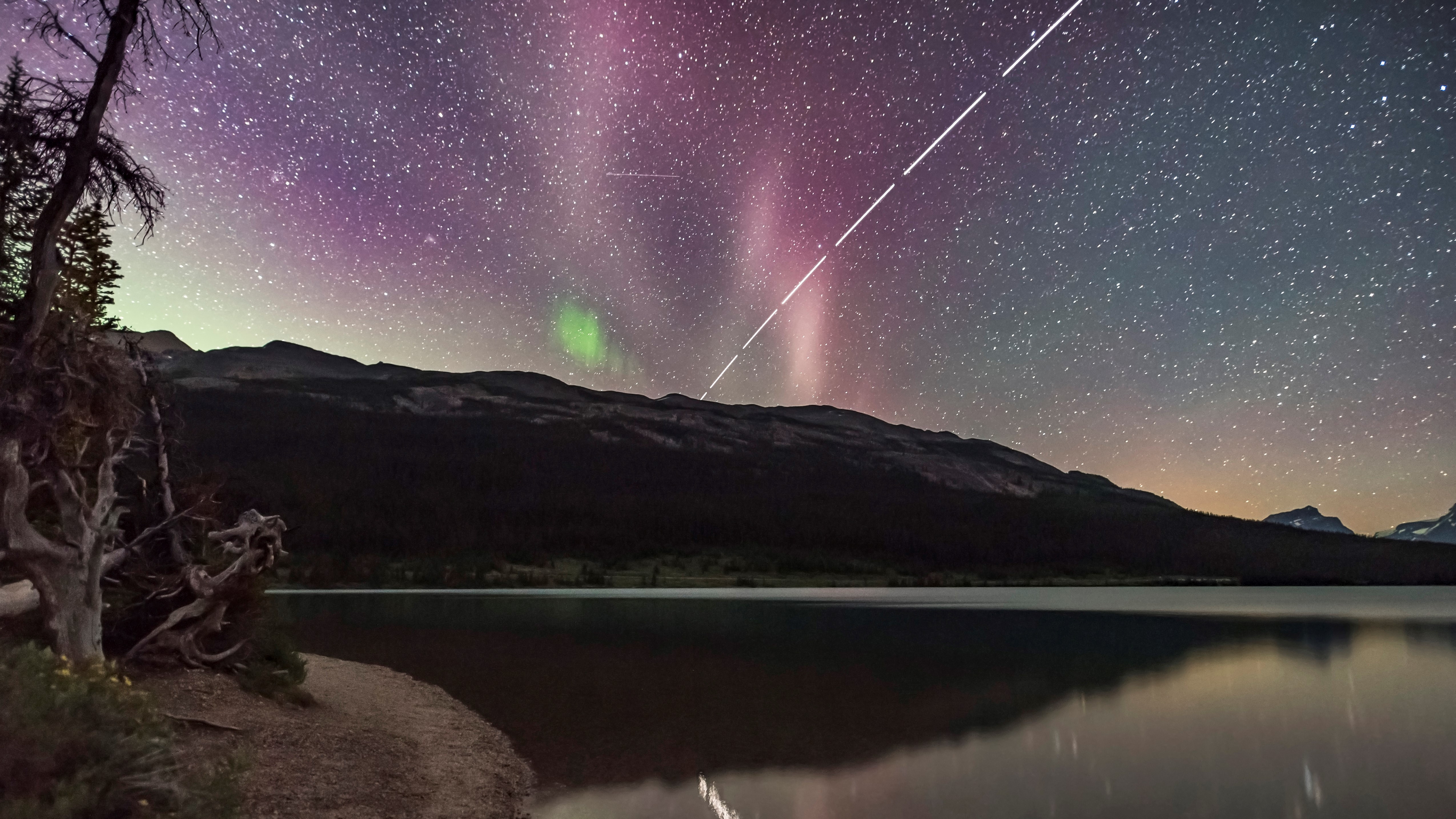Track the ISS: How and where to see it
You can see the International Space Station (ISS) from Earth you just need to know where and when to look.

Track the ISS: TL;DR
The International Space Station is easily visible from Earth, and can often be the brightest object in the night sky. You can track the ISS using smartphone apps that send you notifications when it will be passing overhead, or use NASA's Spot the Station website to know where and when to look. The European Space Agency also has an online live map that shows where the ISS is as well as its speed and altitude.
The International Space Station (ISS) is a multi-nation laboratory, orbiting 248 miles (400 kilometers) above our heads. It perhaps comes as no surprise that it's easy to see and track the ISS from Earth.
We can see the ISS from Earth because the colossal structure reflects sunlight, appearing as a bright white pinpoint of light in the sky. When visible, the ISS will typically be the brightest object in the sky (except for the moon), and can even be spotted from the middle of a city.
You don't need any specialist skywatching equipment to see the ISS as it is visible to the naked eye. It is therefore a great skywatching target for those living in urban and rural areas alike, as anyone with a view of the sky can potentially see and track the ISS.
Related: Smartphone astrophotography: How to take pictures of the night sky
Where and when can I see the ISS?
"The International Space Station's trajectory passes over more than 90% of Earth's population," according to a statement from NASA. The ISS zips around Earth at an average speed of 17,500 mph ( 28,000 km/h), completing 16 orbits per day. As the ISS orbits with an inclination of 51.6 degrees, if you live beyond 51.6 degrees north or south of the equator the ISS will never appear directly overhead.
The ISS is only visible because it reflects sunlight. It isn't bright enough to be seen in the middle of the day and the best time to view the ISS is either at dawn or dusk. Viewing opportunities of the ISS can vary between one sighting a month to several a week, depending on your location and the orbit of the ISS.
Breaking space news, the latest updates on rocket launches, skywatching events and more!
ISS predictions and alerts
NASA's spot the station widget (below) is a great tool for quickly finding out upcoming ISS viewing opportunities. Simply pop in the location you wish to know for ISS sighting opportunities and let the widget work its magic. It will tell you the time of the ISS flyover along with how long it is visible, the maximum height it will reach in the sky and which direction it will appear and disappear from your field of view.
In addition, NASA's Spot the Station website is a great place to explore ISS sighting opportunities in your area. You can even sign up for email or text alerts for when the space station is flying over so you'll never miss a viewing opportunity again.
Though it's worth noting you will only get NASA's Spot the Station alerts when the ISS is passing over with a maximum height of at least 40 degrees, this is because the ISS will be visible above most landscapes at this height.
NASA has also released a "Spot The Station" app, which can be downloaded for free on iOS and Android devices. The app builds on the space agency's official "Spot the Station" website and provides a wealth of information and added capabilities to help curious skywatchers see and track the ISS.
If you would like to know where the space station is right now, ESA's live map has got you covered. The informative map shows where the ISS is as well as its speed and altitude.
Photographing the ISS
The ISS makes for a fun and interesting observing target in the night sky. With its location and movement tracked with great accuracy as well as night sky alerts from NASA's Spot the Station website, it's perhaps one of the easiest objects to spot in the night sky.
Related: How to photograph the ISS
Budding astrophotographers from around the world have caught beautiful long-exposure photographs that show the ISS appearing to streak across the sky. To the ground observer, the ISS passing overhead will appear as a bright point of light moving quickly across the sky, similar to a plane but brighter and without the flashing lights.
If you would like to have a go at photographing the orbiting observatory, consider our best cameras for astrophotography and the best lenses for astrophotography.
ISS transit photography expert Q&A
We spoke to astrophotographer Thierry Legault to find out what goes on behind the scenes of his incredible ISS transit footage. From location planning, timings and the equipment needed for the perfect shot.
Thierry Legault is a French astrophotographer and author. His photographs have been featured in publications around the world and he has written three books; The New Atlas of the Moon with Serge Brunier (Firefly), Astrophotographie (Eyrolles), translated in English, German and Spanish and Les Secrets de l'Astrophotographie (Eyrolles).
How do you prepare to capture an image of the ISS?
First, I use transit-finder.com to find out where and when transits are visible within a radius of several hundreds of km around my home. I also have to consult the weather forecast during the days before the event, to assess the probability of a clear sky and determine the best area to go (a transit line is very narrow but very long).
I arrive very early in the chosen area because I still have to find a suitable spot, a place where I've never been and where I will probably never go again. And that's one of the most difficult parts of the challenge, it often takes one hour or more. I have to avoid urban areas (too many buildings, roads and streets). Land areas may look better but many trees, electric wires, or private properties are not good.
Once a spot is found, I run transit finder again because the calculation is renewed every 2 to 3 hours and the trajectory can change significantly.
What challenges do you face when capturing ISS transit images?
Success needs many factors, in particular:
- A clear sky in front of the sun at the precise moment of the transit
- No mistake in the choice of the observation site
- Good view, to get a stable and detailed image.
Most of the time, especially during daytime because of the heating of the ground by the sun, there is a lot of turbulence which blurs the view. The greater the focal length of the lens or the telescope, the bigger the risk of getting fuzzy images!
- Good focusing: On my refractor, focusing is manual and the necessary precision of adjustment is 0.002"
If one link of the chain is defective, the result will be poor, or even non-existent.
- Good choice of exposure: Too bright and the image is overexposed, too dim and there is noise in the image. All the more that the ISS is extremely fast (27000 km/h) and an exposure time that is too long gives a fuzzy ISS because of the movement.
The longest exposure time is not fixed, it depends on the characteristics of the transit, particularly the distance of the ISS at the moment of the transit (given by transit-finder.com), and the focal length used. The closer the ISS and the longer the focal length, the shorter the exposure time!
- Shooting at the right moment of the transit. Working in video is easier because one can start to film one minute or so before the calculated time and stop after the transit. But in video mode, the quality of the image will be lower than in a photo (lower resolution, higher noise and compression artifacts). So, I prefer to work in continuous shooting, but generally, the duration of the burst is limited and then I can use a radio-synchronized watch to start the sequence at the right moment
Of course, for a solar transit, a safe solar filter is absolutely mandatory, I recommend the Baader Astrosolar film which is cheap and high quality, if possible in photo density 3.8.
For a lunar transit, no filter is required.
How do you feel when you see the ISS?
For specific transits, I already traveled more than 1,000 kilometers (620 miles) by car (transit of the ISS and Atlantis in 2010 from Spain and Switzerland), and even overseas (transit of Atlantis after launch in 2009 from Florida, transit of the ISS and Mercury in 2016 from Philadelphia)
In this case, you can imagine that there is a lot of adrenalin, a bit like a total eclipse. I have prepared everything carefully, set up the telescope in an unknown place and waited for the precise moment hoping that all the conditions will be met.
When the transit happens, the ISS is generally too fast to see it transiting live on the camera screen. I have to remove the camera from the telescope and examine all the images one by one to check if the ISS is there, in a good position and sharp. Maximum suspense, because I had only one opportunity!
Additional Reading
If you would like to track the ISS along with other Earth-orbiting satellites, check out the N2YO website. Heavens-Above is also a good place to find more ISS tracking information as well as other astronomy resources. Both sites ask you to put in location information and generate tables with viewing times and directions to look to serve as a guide.
You can learn more about the International Space Station with ESA. Check out Transit Finder to plan observations of transit events of the ISS in front of the sun and moon. Warning: NEVER look at the sun with binoculars, a telescope or your unaided eye with out special protection. Astrophotographers and astronomers use special filters to safely observe the sun while photographing ISS transit, solar eclipses or other sun phenomena. Here's our guide on how to observe the sun safely.
Bibliography
- Montenbruck et al. "Orbital Determination and Prediction of the International Space Station", Journal of Spacecraft and Rockets, Volume 48, No.6, November-December 2011.
- "The International Space Station" by Clive Gifford (Wayland, 2017).
- NASA's Spot the Station.
- ESA's ISS tracking map.

Daisy Dobrijevic joined Space.com in February 2022 having previously worked for our sister publication All About Space magazine as a staff writer. Before joining us, Daisy completed an editorial internship with the BBC Sky at Night Magazine and worked at the National Space Centre in Leicester, U.K., where she enjoyed communicating space science to the public. In 2021, Daisy completed a PhD in plant physiology and also holds a Master's in Environmental Science, she is currently based in Nottingham, U.K. Daisy is passionate about all things space, with a penchant for solar activity and space weather. She has a strong interest in astrotourism and loves nothing more than a good northern lights chase!




